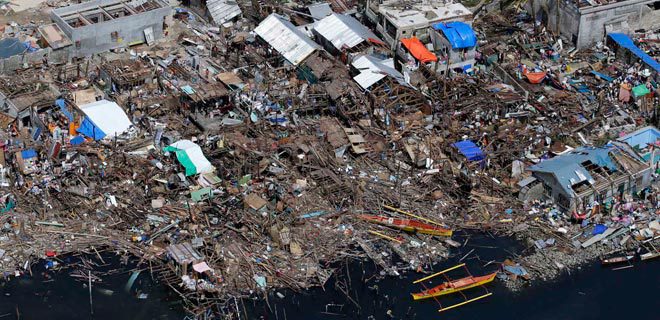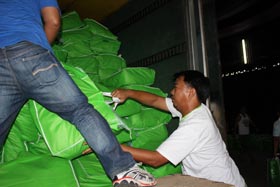Why does it take so long for aid to be delivered and more of your questions.

The Philippines Government response
The Philippines Government is traditionally quick at responding to humanitarian emergencies and our impression is that it is doing as good a job as it can, given the massive challenges. Remember that government officials, public servants and first responders in the affected areas are likely to have also suffered loss of their homes and death of loved ones, as well as having to deal with the damage to their offices, vehicles, and communications capacity etc. Of course they can do more and it is a critical role for international organisations to help these institutions at local and provincial level to restore their capacity and not bypass them. And these are the institutions that will have to oversee the longer term recovery and reconstruction.
Why is does it take so long for aid supplies to reach the Philippines?
The airports are being overwhelmed with the amount of supplies arriving by air. We have to ensure that we do not add to congestion at the airport and even further delay the delivery of aid. Some of the airports are closed and there are very few commercial flights to the affected areas. Tacloban for example has only been taking military flights. Coordinating the aid effort and avoiding a bottleneck is really important when there is so much need and so many aid flights.
Not enough aid has arrived in the first five days
 |
| Hygiene kits arrive today at Cebu Airport from Manila, to be ready for dispatch to typhoon affected areas. Oxfam is planning to distribute about 3000 hygiene kits in the coming days. Photo: Chee Chee Leung/OxfamAustralia |
Aid is starting to get through to some of the areas affected. Today rice has been distributed to 50,000 people in the Tacloban area. 4,000 plastic sheets and tents have been delivered to Tacloban City to provide emergency shelter. 4,700 pieces of debris clearing equipment (chainsaws, wheelbarrow, shovels) and power generators have been supplied to some of the worst affected areas. A total of 10,000 tarpaulins, 9,700 shelter kits and 11 metric tons of high energy biscuits are in Manila, awaiting delivery to the worst affected areas.
But we are still well short of the scale and reach required. Delivering relief continues to be challenged by damaged infrastructure such as airports, roads and ports. The onset of rains is bringing further suffering to people living without shelter and compounding the logistical challenges.
The UN agencies, the government and aid agencies are daily improving coordination on logistics, maximising the use of functional airports, clearing roads for access and improving security.
How is the response being coordinated?
The Philippines Government has a great deal of experience dealing with the large storms, but the devastation caused by typhoon Haiyan has been unprecedented. The government is working together with aid agencies to coordinate getting assistance to those who need it the most. Oxfam has a history of working with local partners in the Philippines to respond to disasters.
What can be done to speed up the humanitarian relief?
The UN classification of the crisis at its highest level should mean mobilisation of UN agencies top staff and greater resources. Rapid investment in transport, including air transport, along with improved telecommunications is vital. There is a need for stronger and quicker centralised decision-making for food, water, shelter, and medicines to reach affected people. The government also needs to be clear about who is on top of the efforts at both national and local levels so as to reach the most affected.
Are Typhoons like Haiyan common in the Philippines?
The Philippines is one of the countries worst affected by typhoons. The typhoon season typically runs from June to November and the country on average experiences 20 typhoons a year. In the last few months the country has already experienced typhoon Utor, storms causing flooding in Manila and an earthquake in Bohol. While technology now makes it easier for typhoons to be predicted, the devastation caused by Haiyan was unprecedented, not least because the storm surge caused coastal flooding, described by eyewitnesses as a tsunami. “We only know of rain and wind. We did not expect the sea would devour the land.”
It has been reported that the typhoon is as bad as the 2004 Indian Ocean tsunami, what is your reaction to this?
Aid workers who also responded to the tsunami have reported scenes in some places in the Philippines to be similar to the devastation caused in 2004. An eyewitness in Tacloban told us that during the typhoon the sea literally devoured the land.
However, we are not at the moment suggesting the number of people killed/affected is equal to the effects of the tsunami, though the economic damage may be comparable.
Is the Philippines typhoon linked to climate change?
Typhoon Haiyan is the strongest tropical cyclone to make landfall in history. The immediate priority is to get help to the communities that have been devastated. Oxfam is gearing up its aid efforts and is looking to reach half a million people affected by the typhoon. The storm is also a poignant reminder of why governments need to make real progress at the UN climate change talks taking place now in Warsaw. The science tells us that at current and rising levels of emissions we are increasing the likelihood of more severe tropical storms like Haiyan happening. Developed countries must increase the amount of finance they put on the table to help poor countries adapt and cope with climate change and all governments must ensure that they urgently drive down their countries’ emissions.
Are security issues stopping aid getting through?
There have been cases of looting, but this has been by people trying desperately to get the food, water and medicines they need for themselves and their families. This underlines the importance of getting aid through as soon as possible. There have been acts of violence, but these are isolated.
We have to ensure that distributions can be managed in an orderly way. Oxfam manages security risks carefully and works closely with local communities to minimise them. We avoid putting communities, partners or staff in unnecessary danger.
People need aid now, why are you still assessing?
Assessments are needed to identify accurately what exactly is needed in a given area: the volumes required, what other actors are delivering or thinking of delivering. This is essential to avoid gaps and duplication in the aid effort. It is also important to consult with communities and their leaders by engaging with them in discussions about their priorities and about how aid can best be delivered. This is especially important after such a traumatic event, to help communities take some minimal control over their lives and begin the transition back to normal life.
Should you be doing airdrops by helicopters or airplanes?
Oxfam’s experience is that aid air-drops (i.e. dropping aid from aircraft) can very occasionally help but typically are hugely expensive and very limited in what they can deliver. Air dropping aid does not guarantee food and other relief supplies reach the people most in need. In many cases it’s the strongest and fittest who get to the aid first and not the sick or injured who most need help and assistance.
In a natural disaster such as this one, it’s not only food that’s needed but also sophisticated equipment such as clean water and sanitation systems weighing tons as well as highly skilled staff to operate them – none of which can be dropped from the sky. If there isn’t an aid operation on the ground to distribute the aid, air-drops can exacerbate any tense relations within communities, with only the fittest and fastest benefiting.
However, air transport into the Philippines and within the country is critical, including helicopter capacity for the more remote areas. Sea ports are now opening up which is a much cheaper way of delivering aid in the Philippines, provided further storms do not disrupt shipping.
How many people need food?
2.5 million people need food, according to the World Food Programme. Some food supplies are beginning to get through, but reserve resources have been overstretched by recent crises, such as the earthquake that shook Bohol last month. Blocked and damaged roads are also hampering the delivery of food to affected people.
People’s normal access to food has been severely damaged – many rice storage buildings have been ruined, meaning people do not have reserves. Business routes from farm to market are blocked, damaged and not operational.
Is there a danger from infectious diseases?
Yes. Water and sanitation systems have been damaged by the typhoon and are non-operational in many areas and some ground water supplies are contaminated. High temperatures and dirty standing water mean the risk of waterborne diseases is high.
Making sure people have access to clean water and sanitation is critical. Oxfam is working to distribute hygiene kits and clean drinking water, and establish hygienic latrines to prevent human sewage from contaminating water sources.
MSF have warned that more people may die from thirst and hunger and because of a lack of sanitation and polluted flood water. Many wounds have been left untreated due to lack of medical supplies. The few hospitals left standing have had to turn people away because they’ve been overwhelmed. Many people desperate for medical care have made their way to the airport, where the military is trying to administer care.
Background of Oxfam’s work in the Philippines
Rising food prices, a growing population and a shortage of suitable land for crops mean that poverty is a major issue in the Philippines. Women are particularly badly affected, and violence against women is also a big problem here. On top of this, the country is vulnerable to floods, earthquakes, landslides and typhoons. Oxfam creates more opportunities for women here by providing vital tools, advice and financial assistance. We also help people in high risk areas prepare for natural disasters and get back on track in the aftermath.



